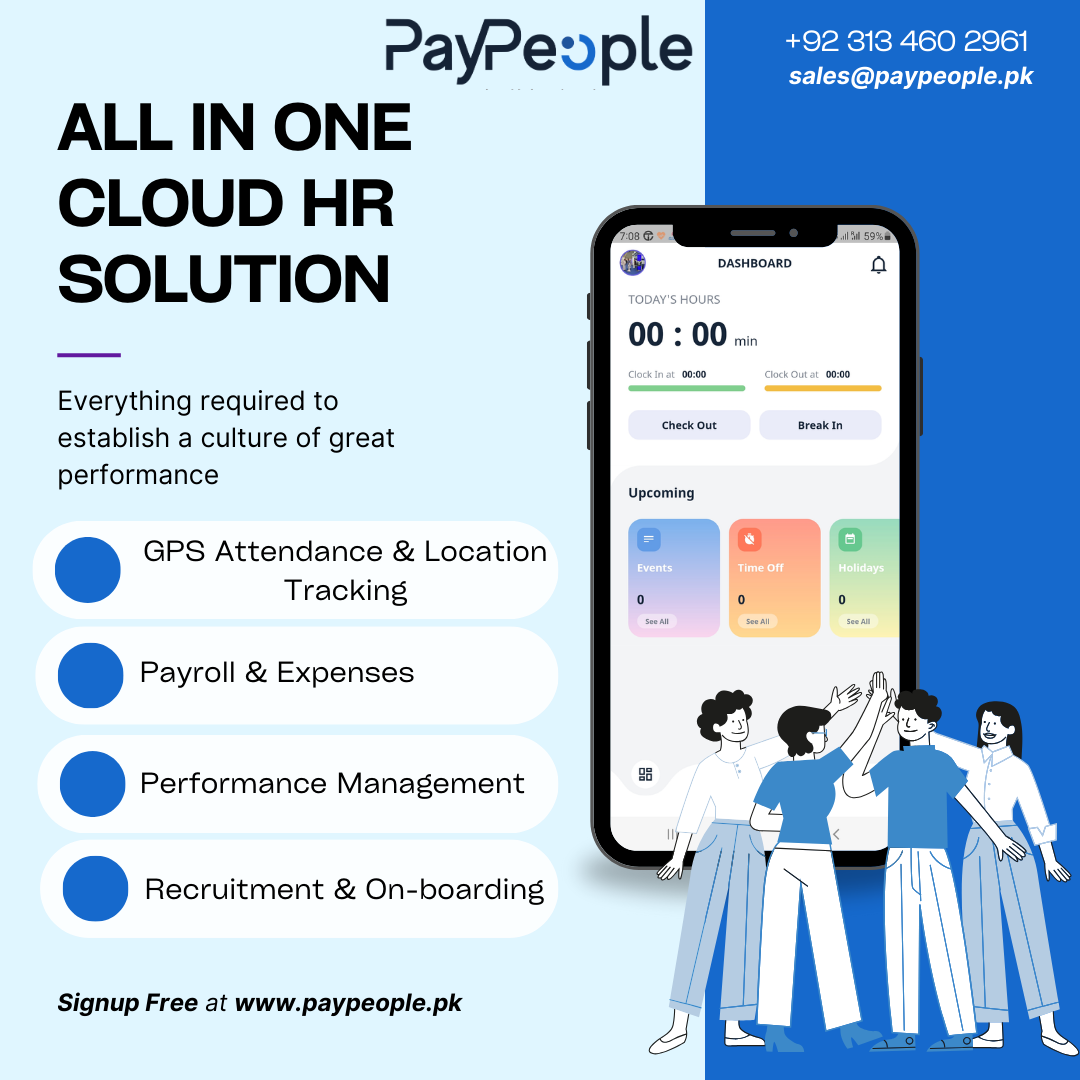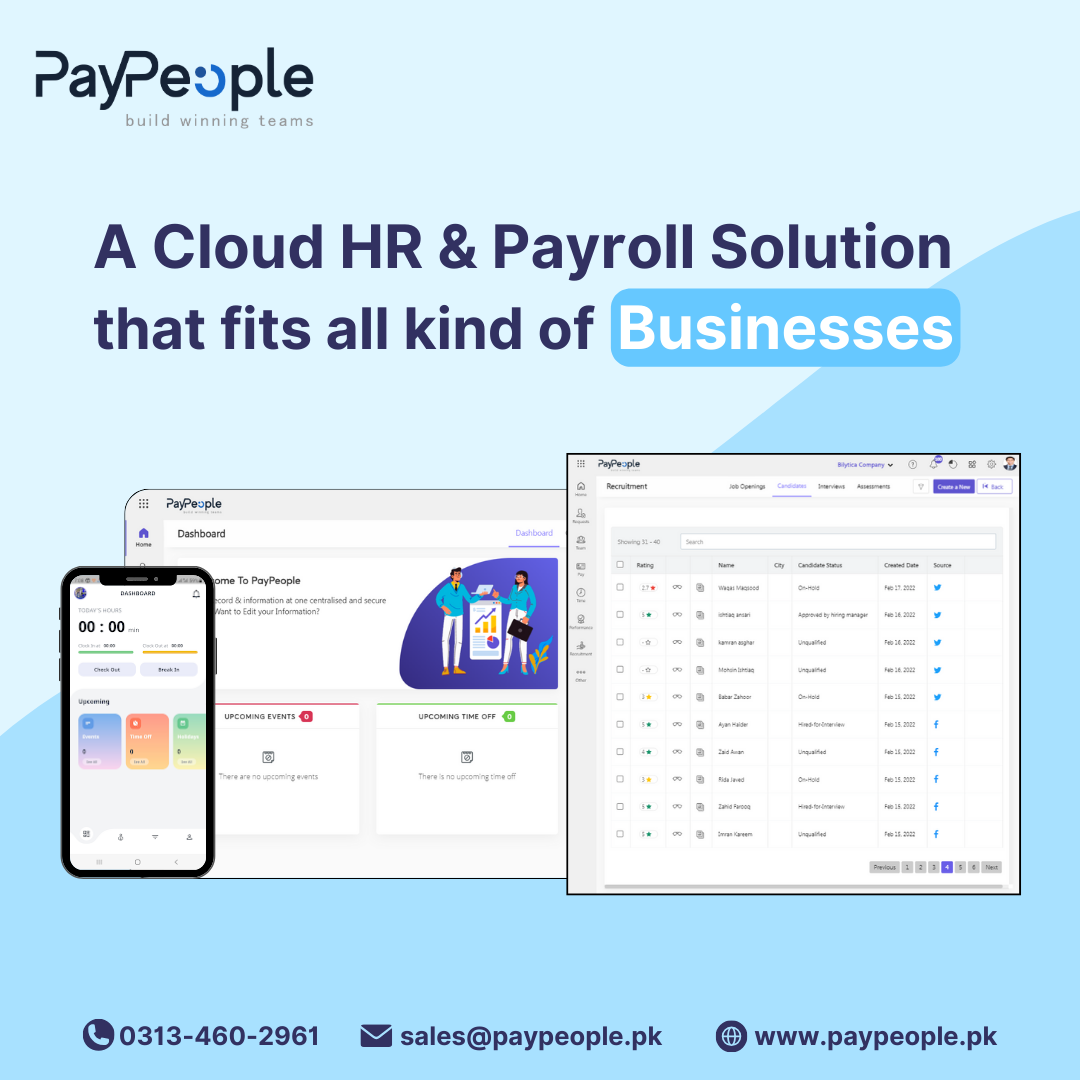Paypeople # 1 is one of the top Human Resource Planning a strategy-oriented process organizations use to ensure that their workforce is aligned to the objectives and goals of their business. In this complex process of managing talent, a key player emerges as essential workforce analysis. The process of workforce analysis involves the thorough study of an organization’s present and projected workforce, as well as assessing their strengths weak points, and growth potential. This tool for analysis plays an essential role in the effectiveness of Human Resource Planning by providing insight into the needs of staffing and gaps in skill, as well as overall readiness for the workplace.
Click to Start Whatsapp Chat with Sales
Call #:+923000507555
Email: sales@Paypeople.pk
Paypeople # 1 Human Resource Planning

Understanding Workforce Analysis
The fundamental concept behind analysis of the workforce involves collecting data, interpreting, and using information about the organization’s workforce. The process goes beyond headcount statistics and goes into the world of competencies, skills, and demographics, as well as performance indicators. Through the analysis of this data, Human Resource Planning gains a comprehensive view of the employee environment, allowing them to make informed choices that will lead to organizational success.
The Core Components of Workforce Analysis
Map of Skill
The analysis of the workforce begins by conducting a thorough analysis of the competencies within the workplace. This involves identifying the present abilities of employees, evaluating their importance to the organization’s goals and anticipating future needs. Skill mapping allows HR professionals to identify the areas of weakness and strength which allows them to focus training and development programs.
Demographic analysis
Knowing the demographic characteristics that the population is essential for a successful HRP. Demographic analysis focuses on aspects like gender, age, educational background, and levels of experience. This data aids in developing strategies to deal with diversification and integration, as well as succession plans and the ever-changing demands of a workforce that is multigenerational.
pipelines and planning for success
Analysis of the workforce assists in identifying potential employees and in establishing pipelines of talent for important jobs. Succession planning is a crucial component of Human Resource Planning and is based on knowledge gained from the analysis of the workforce to ensure smooth transitions of leadership and to ensure that the organization has continuity.
Measures of Employee Performance
Evaluating individual and team performance metrics is essential to analyzing the workforce. This involves evaluating the level of engagement, productivity, and important metrics of performance (KPIs). By identifying employees who are performing well and areas that need improvement, HR will be able to make educated decisions about retention of talent, promotions, as well as areas that require further training.

External Workforce Trends
A successful analysis of the workforce does not just happen in isolation, it also takes into account external influences. Analyzing trends in the industry technology advancements, trends in the field, and market dynamics allow HR Planning experts to predict changes in skills demands and adjust the workforce to meet these changes. This knowledge is crucial to being competitive in an ever-changing business environment.
The Role of Workforce Analysis in Human Resource Planning
Strategic Alignment
Workforce analysis makes sure that the structure and capabilities of the workforce are aligned with the company’s goals and objectives. This alignment is vital to reaching business goals because hiring the best talent for the right position maximizes effectiveness and efficiency.
Recognizing Skill Gaps
By mapping skills and analysis, HR specialists are able to determine the gaps in skills within the workforce. This information is crucial in the design of training programs, hiring outside talent, or changing job roles to fill in these gaps and improve the overall capabilities of the organization.
cost optimization
Analysis of the workforce assists in reducing costs by pinpointing areas in which resources are underutilized or in areas where more investment is required. This lets HR Development make informed choices on the allocation of resources and ensures an equilibrium between financial efficiency and operational prudential.
Risk Mitigation
Knowing the demographics and abilities of employees allows organizations to anticipate risk factors, like gaps in succession, talent shortages, or redundancies of workers. This knowledge empowers HR to put into place risk mitigation strategies to reduce the effects of unanticipated issues.
Enhancing Engagement with Employees
By leveraging workforce analysis, HR can develop strategies to boost the engagement of employees. This can include the recognition and reward of top performers, addressing issues identified by performance metrics, and creating an environment of work that is a reflection of the aspirations of employees.
Conclusion
In the end, understanding how to analyze your workforce is the key to successful Human Resource Planning. It helps organizations traverse the complexities of the management of talent by ensuring that they align the goals of the workforce to strategic ones and ensuring long-term performance. Through the study of skills mapping and demographic analysis, as well as performance metrics, talent pipelines and trends from outside HR professionals are able to make data-driven decisions to optimize cost, minimize risks, and boost employee engagement. As companies continue to change in a constantly changing market, the significance of analyzing the workforce in shaping the workplace of tomorrow is not overstated. It’s the compass that directs HR personnel in steering their companies toward a more robust, flexible, and efficient workforce.
Click to Start Whatsapp Chat with Sales
Call #:+923000507555
Email: sales@Paypeople.pk
Human Resource Planning
Human Resource Planning
Human Resource Planning
Human Resource Planning
We are one of the best What are the key features of HR Information System? Price in Pakistan in Azad Kashmir, Bagh, Bhimber, khuiratta, Kotli, Mangla, Mirpur, Muzaffarabad, Plandri, Rawalakot, Punch, Balochistan, Amir Chah, Bazdar, Bela, Bellpat, Bagh, Burj, Chagai, Chah Sandan, Chakku, Chaman, Chhatr, updated on 2024-01-23T05:02:34+00:00 Dalbandin, Dera BugtiBarcode Shop offer lowest What are the key features of HR Information System? Price Face Recognition in cities Dhana Sar, Diwana, Duki, Dushi, Duzab, Gajar, Gandava, Garhi Khairo, Garruck, Ghazluna, Girdan, Gulistan, Gwadar, Gwash, Hab Chauki, Hameedabad, Harnai, Hinglaj, Hoshab, Ispikan, Jhal, Jhal Jhao, Jhatpat, Jiwani, Kalandi, Kalat, Kamararod, Kanak, Kandi, Kanpur, Kapip, KapparWe can deliver Face Recognition in Karodi, Katuri, Kharan, Khuzdar, Kikki, updated on 2024-01-23T05:02:34+00:00 Kohan, Kohlu, Korak, Lahri, Lasbela, Liari, Loralai, Mach, Mand, Manguchar, Mashki Chah, Maslti, Mastung, Mekhtar, Merui, Mianez, Murgha Kibzai, Musa Khel Bazar, Nagha Kalat, Nal, Naseerabad, Nauroz Kalat, Nur Gamma, Nushki, Nuttal, Ormara, Palantuk, Panjgur, Pasni, Piharak, Pishin, Qamruddin Karez, Qila Abdullah, Qila Ladgasht and this was updated on 2024-01-23T05:02:34+00:00 We also deal with What are the key features of HR Information System? Price in Qila Safed, Qila Saifullah, Quetta, Rakhni, Robat Thana, Rodkhan, Saindak, Sanjawi, Saruna, Shabaz Kalat, Shahpur, Sharam Jogizai, Shingar, Shorap, Sibi, Sonmiani, Spezand, Spintangi, Sui, Suntsar, Surab, Thalo, Tump, Turbat, Umarao, pirMahal, Uthal, Vitakri, Wadh, Washap, Wasjuk, Yakmach, Zhob, Federally Administered Northern Areas/FANAWe are already sent Face Recognition to these places – Astor, updated on 2024-01-23T05:02:34+00:00 Baramula, Hunza, Gilgit, Nagar, Skardu, Shangrila, Shandur, Federally Administered Tribal Areas/FATA, Bajaur, Hangu, Malakand, Miram Shah, Mohmand, Khyber, Kurram, North Waziristan, South Waziristan, Wana, NWFP, Abbottabad, Ayubia, Adezai, Banda Daud Shah, Bannu, Batagram, Birote, Buner, Chakdara, Charsadda, Chitral, Dargai, Darya Khan, Dera Ismail Khan and this was updated on 2024-01-23T05:02:34+00:00 we are planning to open a branch office of in Drasan, Drosh, Hangu, Haripur, Kalam, Karak, Khanaspur, Kohat, Kohistan, Lakki Marwat, Latamber, Lower Dir, Madyan, Malakand, Mansehra, Mardan, updated on 2024-01-23T05:02:34+00:00 Mastuj, Mongora, Nowshera, Paharpur, Peshawar, Saidu Sharif, Shangla, Sakesar, Swabi, Swat, Tangi, Tank, Thall, Tordher, Upper Dir, Punjab, Ahmedpur East, Ahmed Nager Chatha, Ali Pur, Arifwala, Attock, Basti Malook, BhagalchurFace Recognition in Bhalwal, Bahawalnagar, Bahawalpur, Bhaipheru, Bhakkar, Burewala, Chailianwala, Chakwal, Chichawatni, Chiniot, Chowk Azam, Chowk Sarwar Shaheed, Daska, Darya Khan, Dera Ghazi Khan, Derawar Fort, updated on 2024-01-23T05:02:34+00:00 Dhaular, Dina City, Dinga, Dipalpur, Faisalabad, Fateh Jang, Gadar, Ghakhar MandiFace Recognition What are the key features of HR Information System? Price s Demands very high in Gujranwala, Gujrat, Gujar Khan, Hafizabad, Haroonabad, Hasilpur, Haveli Lakha, Jampur, Jhang, Jhelum, Kalabagh, Karor Lal Esan, Kasur, Kamalia, Kamokey, Khanewal, Khanpur, Kharian, Khushab, Kot Addu, Jahania, Jalla Araain, Jauharabad, Laar, Lahore, Lalamusa, Layyah, Lodhran, Mamoori, Mandi Bahauddin, Makhdoom Aali, Mandi Warburton, Mailsi, Mian Channu, Minawala, Mianwali, Multan, Murree, Muridke, Muzaffargarh, Narowal, Okara, Renala Khurd, Rajan Pur, Pak Pattan, Panjgur and this was updated on 2024-01-23T05:02:34+00:00 and current What are the key features of HR Information System? Price of is Rs 100 in Pattoki, Pirmahal, Qila Didar Singh, Rabwah, Raiwind, Rajan Pur, Rahim Yar Khan, Rawalpindi, Rohri, Sadiqabad, Safdar Abad – (Dhaban Singh), Sahiwal, Sangla Hill, Samberial, Sarai Alamgir, Sargodha, Shakargarh, Shafqat Shaheed Chowk, Sheikhupura, Sialkot, Sohawa, Sooianwala, Sundar (city), Talagang, Tarbela, Takhtbai, Taxila, Toba Tek Singh, Vehari, Wah Cantonment, Wazirabad and this was updated on 2024-01-23T05:02:34+00:00 Software solutions are widely available with Price updated on 2024-01-23T05:02:34+00:00 in Sindh, Ali Bandar, Baden, Chachro, Dadu, Digri, Diplo, Dokri, Gadra, Ghanian, Ghauspur, Ghotki, Hala, Hyderabad, Islamkot, Jacobabad, Jamesabad, Jamshoro, Janghar, Jati (Mughalbhin), Jhudo, Jungshahi, Kandiaro, Lahore, Kashmor, Keti Bandar, Khairpur, updated on 2024-01-23T05:02:34+00:00 Khora, Klupro, Khokhropur, Korangi, Kotri, Kot Sarae, Larkana, Lund, Mathi, Matiari, Mehar, Mirpur Batoro, Mirpur Khas, Mirpur Sakro, updated on 2024-01-23T05:02:34+00:00 Mithi, MithaniThe Barcode Shop deliver high quality Face Recognition in updated on 2024-01-23T05:02:34+00:00 Moro, Nagar Parkar, Naushara, Naudero, Noushero Feroz, Nawabshah, Nazimabad, Naokot, Pendoo, Pokran, Qambar, Qazi Ahmad, Ranipur, Ratodero, Rohri, Saidu Sharif, Sakrand, Sanghar, Shadadkhot, Shahbandar, Shahdadpur, Shahpur Chakar, Shikarpur, Sujawal, Sukkur, Tando Adam, Tando Allahyar, Tando Bago, Tar Ahamd Rind, Thatta, Tujal, Umarkot, Veirwaro, Warah and this was updated on 2024-01-23T05:02:34+00:00
23-1-2024


